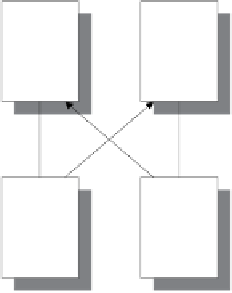Information Technology Reference
In-Depth Information
Fig. 3.25
m:n relationship
with redundant hierarchical
segments
(PSOR\HHV
3URMHFWV
3URMHFWV
(PSOR\HH
,06/2*,&$/'$7$%$6(
/3
/3
6(*0(17
6(*0(17
/3
(17,7<
(17,7<
(03/2<((
352-(&76
P
Q
:25.
21
(03/2<((
352-(&76
6(*0(17
6(*0(17
/&
/&
/&
&255(6321',1*((502'(/
(03/2<((
352-(&76
352-(&76
(03/2<((
3$,5('6(*0(176
:KHUH/3 ORJLFDOSDUHQWDQG/& ORJLFDOFKLOG
Fig. 3.26
Map IMS logical database into EER model
3.5
Translating a Relational Model into an EER Model
Although the relational data model has become the standard for data processing
applications, its data modeling is extremely limited when compared with object-
oriented data model. For object-oriented data model, however, at present there are
no formal standards describing the exact format and syntax for representing an ob-
ject-oriented database. Therefore, in the work described below, we define a meth-
odology to reengineer existing relational model schemas into the UML model. The
relational model is first reverse engineered into an EER model with user's input to
recover some lost semantics. The EER model is then mapped into an UML model.
This latter transformation is prescribed by a set of transformation rules devised by
the author. Such reengineering practices can not only provide us with significant
insight to the “interoperability” between the object-oriented and the traditional se-
mantic model techniques, but also can lead us to the development of a practical
design methodology for object-oriented database.











Search WWH ::

Custom Search